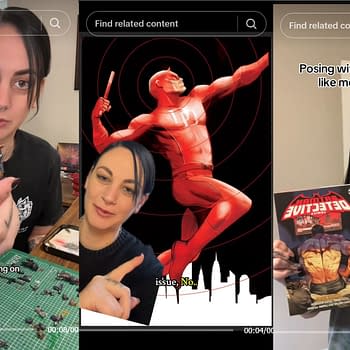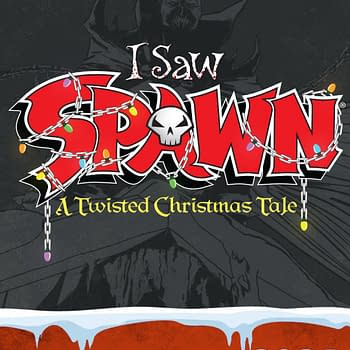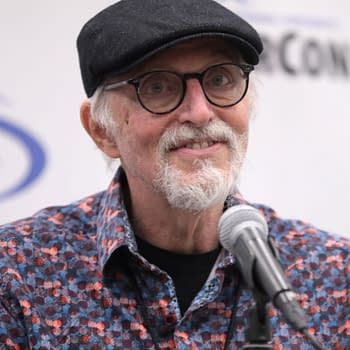Posted in: Comics, Recent Updates | Tagged: Captain Canuck, Comics, Convergence Week 8, dc comics, entertainment, Fight Club 2, Marvel Comics, old man logan, providence, Secret Wars
Thor's Comic Review Column: Convergence Week 8, Providence, Fight Club 2, Captain Marvel #15, Secret Wars: Where Monsters Dwell #1, Old Man Logan #1, Uncanny Avengers: Ultron Forever #1, Captain Canuck #1
This Week's Reviews:
Convergence Week 8
Providence #1
Fight Club 2 #1
Captain Marvel #15
Secret Wars: Where Monsters Dwell #1
Secret Wars: Old Man Logan #1
Uncanny Avengers: Ultron Forever #1
Captain Canuck #1
Convergence Week 8
By Graig Kent
For the past three years the Avengers and New Avengers have been flirting with the destruction of the entire Marvel multiverse. The two series built initially towards the Infinity event, which both distracted from and weaved itself into the story of universal conflicts as two parallel earths threatened to crash into one another destroying them both, unless one was destroyed first. Infinity waged war across the universe, an alien armada heading towards Earth while its greatest minds were distracted by the impending end of everything. Even after the war abated and Infinity ended, changing somewhat the landscape of Marvel earth today, but the threat of parallel earths colliding still existed. I've just finished reading The Avengers: Time Runs Out volumes 2 & 3, and I know it all leads to Secret Wars where the landscape of the Marvel Universe finds its few remaining multiversal entities all smashed together, but I just don't know how yet. I'm absolutely dying to know.
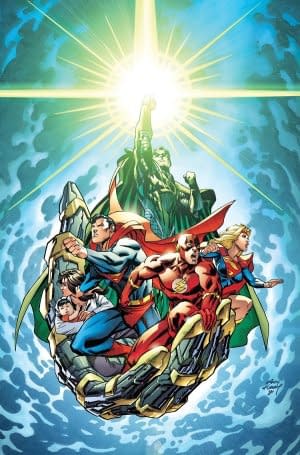
Up to this point I've been fairly forgiving in my assessment of the series and even the event as a whole. It was probably a survival tactic, knowing that I still had more to endure, I needed to convince myself that in some small way there was something redemptive about it. Yet, I come to the end (which Rich summarizes concisely here, should you like to spoil it for yourself…but, let's be honest, if you've not been reading Convergence all along, chances are you're not going to retroactively do so) with no delusions that Convergence was mostly a waste of time, money, talent, investment, not to mention the ecological impact of cutting down all those trees, processing all that paper, consuming all that energy printing and distributing, or all the computer processing power put to writing and reading about it all, all so the main staff at DC could take time off and move.
I look at what Convergence accomplished so haphazardly and so unsatisfyingly, with the hands of dozens of people involved, starting with the creative teams of Superman:Doomed and Futures End and Earth 2: World's End, and then I look at what the Avengers and New Avengers accomplished focussed from the pen of one man, Jonathan Hickman (not to ignore his impressive roster of artistic talent and editorial support), and the end destination seems to be exactly the same, only one is so much more satisfying than the other.
Convergence concludes with the retroactive birth of the New 52. As pointed out in the link above, the story haphazardly and ruthlessly insinuates itself as a prelude to Crisis on Infinite Earths, Armageddon: 2001, Zero Hour and Multiversity while also acting as postscript to 52 and Earth 2: World's End. I can't say off the top of my head whether the DC multiverse as Morrison mapped it showed up in the New 52 at any point prior to Multiversity, but I imagine something did (at least in Morrison's Action Comics, no?) and thus we've got our first glaring continuity gaffe.
Glaring continuity gaffe aside, I do admit there's a small amount of superficial logic to the conclusion of events here, that the Earths of the New 52 are amalgams of many of the Earths that existed before. In the same way Crisis still allowed the past to live on, though not truly exist any longer, so too does Convergence allow all of DCU history to remain part of history. But even still, I dare not scrutinize it, for even that gesture of good faith would likely fall apart (like if Crisis happens differently thus creating the New 52, then how does Flashpoint happen to create Earth 0?…Ugh, forget I asked). The execution to getting here, particularly in this issue, however, was exceptionally frustrating. With temporal energy running rampant, the hail mary to save the multiverse is thrown a monkey wrench because of the original Crisis. As a result Flash and Supergirl must be sent back to fulfill their destiny. But pre-Flashpoint Superman and Zero Hour Parallax decide to go with them to see if they can't change the events of the Crisis. They succeed (I'm not sure how), off-panel, immediately changing the Earths that survive. How much better would this series have been had this happened in, say issue 3, and issues 4 through 7 relayed the events of what exactly Superman and Flash and Supergirl and Hal Jordan (and others) did differently to abate the Crisis. As it stands, it's straight up Deus Ex Machina.
But beyond that, how insulting is the postscript here, where Green Lantern manages to retrofit Telos into a newly habitable planet for the refugees of Earth 2. All the events of World's End seemed to lead to a Battlestar Galactica/Wagon Train-in-space scenario where the refugees of Earth 2 would struggle to survive and find a new home. Well, they lost one planet, but there's no struggle, it's all been solved. Way to suck any tension or drama out of the conclusion of that 26-part series.
If there's frustration here, it's because nearly every "big thing" DC has done since rebooting — from its weekly series to its annual month-long event interruption — feels like a time waster, like there's no greater plan, and no satisfying conclusions. Even with the past three years of Avengers and New Avengers, the stories continually lead into other stories, but Hickman provides stopping points along the way, a conclusion to the events at hand that were supremely satisfying. DC editorial seems incapable of letting a story exist on its own, they always has to push into something else. At least with the Avengers, I'm given something to care about, a measure of thought and conflict to invest into. My experiences with Futures End, World's End and Convergence have felt less creatively driven, and more like an empty, vapid summer blockbuster directed by Roland Emmerich or Michael Bay, only with endings less satisfying, with too many things dangling for a sequel or spin-off. It's all flash, explosions, destruction and death, little heart or character, and no sense that creative want readers to invest anything beyond the money and the time spent reading… and the latter doesn't really matter.
As a one-time massive DC Comics fan, I was using Futures End, World's End, and Convergence as a (very expensive) barometer of how much I can truly care about the the modern DCU, and the result is disappointing. I gave it my best, but the modern DCU isn't worth the time caring about. Individual titles, like Grayson or Gotham Academy or Batman, can still be worth your while, with great creative teams carving out their own little pocket. But when things get grand, when they go cosmic, there's no point in caring, because it seems like DC doesn't really care about anything other than your money.
Convergence concludes with showing us why the new 52 exists, but doesn't give us a reason to care.
—
The Week 4 tie-ins, starring (mostly) pre-Crisis on Infinite Earths characters were some of the most intriguing to me, to the point that I was eager to read all 10 of them, but needed to budgetarily limit myself to 6. For Week 8, I scaled back even further, dropping Infinity Inc. (Ben Caldwell did not return on art, and it looked like yet another tedious fight book) and Detective Comics (I just wasn't that impressed with #1). I flipped through the second issues of the books I hadn't picked up the first issue of and none of them intrigued me (save maybe Plastic Man and the Freedom Fighters, which looked curiously dark for a Plastic Man story).
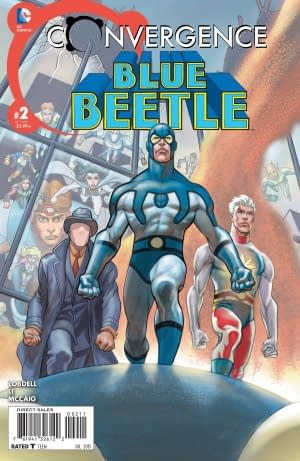
The 8-page preview is of the new Black Canary series from Brendan Fletcher and Annie Wu. Spinning off from Batgirl, it puts Canary as the hard-brawling lead singer of an indie punk band. It feels like a riff on Scott Pilgrim with shades of Spider-Gwen, but not in a flattering way, more in the monkey-see, monkey-do way. It's got spirit, but I feel like I've seen it already.
—
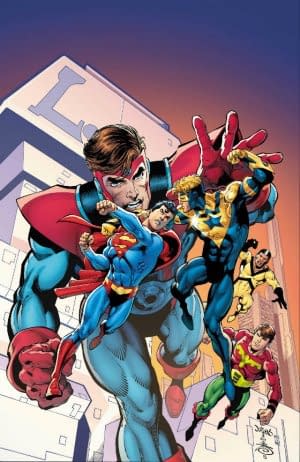
I give Jurgens a lot of credit for the way he's handled Booster, particularly in the New 52. With every event, he manages to make it an important part of the Booster Gold story, rather than just making Booster a participant in it. It makes for a very convoluted trajectory, but in some ways he's the only character taking advantage of DC's complexity, using the universe and its many flavoured variants in inspired ways.
Convergence: Booster Gold #2 (DC, $3.99) should be a more important part of Convergence as a whole but it's Jeff King, not Jurgens who dropped the ball there. For his part, Jurgens provides one of the greatest character services of the entirety of Convergence, giving an aging pre-Flashpoint Booster a reunion with Ted Kord, and really exploring the father-son dynamics between him and Rip Hunter. Jurgens also manages to brilliantly avoid a fight between the New 52 Booster and Superboy and the Legion (there's just not enough time in this story for a dumb Convergence-mandated fight), moving the story along to a very affecting sequence of the dying Booster and his resurrection. As I said, Jurgens found a way to dodge the trappings of Convergence and make an absolutely wonderful story about Booster Gold.
The back-up here is for Earth 2: Society, from Daniel H. Wilson and Jorge Jiminez. I should flat-out avoid this book, based on my severe disappointment with Wilson's handling of Earth 2: World's End as well as my strong dislike for how Convergence #8 so casually solved the dilemma presented by World's End, and yet, I find this 8-page preview, set 2 years later on "New Earth 2", kind of intriguing. There are some wildly interesting ideas at play here (although new Batman is garish). Will I get fooled again and pick it up? Unlikely, but maybe.
—
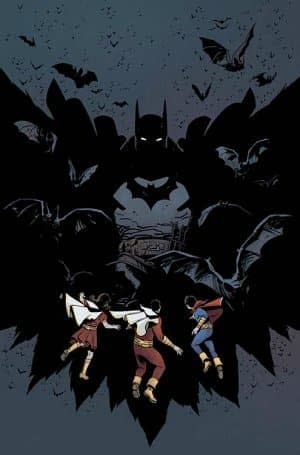
Shaner's visuals are endlessly appealing. Each panel is a gem, worth staring at to marvel at the assuredness of his lines and the remarkable choices he makes to turn each image into something so eye-catching and dynamic.
Parker's script is a romp. He understands the appeal of classic Captain Marvel, and turns it up a few notches. The Shazam we get in the modern Justice League feels like a sham, this is the real deal. The smartest thing DC could do is to give Parker and Shaner (and lest I forget, Jordie Bellaire's deceptively simple, utterly fabulous colors) a Shazam series and keep paying them piles of money to never leave.
The relaunching Constantine: The Hellblazer gets an 8-page back-up story here, written by Ming Doyle and James Tynion IV, with art from Riley Rossmo. I've been eager to see Rossmo enter the mainstream, if only to see what he would do with DC or Marvel's iconic characters (I don't know why I want artists to abandon their own creative endeavours to stunt themselves on corporate properties, but I too often do), but something just feels off here. Rossmo's perhaps too in his element (horror/paranormal) here that it just doesn't stick out enough from his past work, or perhaps after spending so much time soaking in Doc Shaner's visuals I'm worn out. Either way, the harsh dickishness of Constantine is a weird follow-up to the whiz-pow action of Shazam, for sure.
—

If I'm disappointed with the second issue it's not because it's yet another Convergence fight (I think I would appreciate the Seven Soldiers of Victory taking on the Qwardians in any context) but because Fern here is first backed by two different inkers (Joe Rubenstein and Wayne Faucher), each changing the feel of Fern's work noticeably, before he turns the story over entirely to Ron Wagner and Jose Marzan Jr. to complete. Some stories don't demand visual cohesiveness, but this one, which tries to really ground itself in reality with Scribbly's narration, demands it. With Shannon Wheeler subbing in for Scribbly's art, there's enough variation in the storytelling that any further change is that much more distracting.
That said, it's a very inspired tale, picking up the tone from last issue nicely, and carrying it through to its sad, but beautiful farewell as Levitz says a belated goodbye to the pre-Crisis DC Universe he probably grew up loving (or at the very least was gainfully employed by).
The back-up features a preview of We Are Robin! from Lee Bermejo and Jorge Corona. This posits that the kids of Gotham have taken inspiration from Batman's sidekick and venture out into the streets as a collective, tied through social media, as a gang of crimefighters. It's a far-out idea, one that runs the risk of being ridiculous or unbelievable, but Bermejo manages to make it feel fresh and vital. This feels like a book I would really key into as a teenager, as it actually feels like it's full of promise and hope for making something better.
—
Convergence Wrap-up: Bests and Worsts
I'm quite thankful that Convergence is now over. I wish I could be happier with seeing old friends from the DCU past again, but instead I was alternatingly depressed, annoyed, or frustrated with the bulk of what I read. The repetivity of both the first issue reintroduction and the second issue fight that editorial asked their tie-in writers to execute was the biggest mistake. Nostalgia would have sold books far better than endless lame boxing matches.
There was an opportunity here for some real fanfare, a way of going back to DC's rich historical well and giving readers a sweet blast of nostalgia, but instead they tried to couch it in something modern, something attention getting, and something invariably unfulfilling. It would have taken a lot more editorial coordination and genuine enthusiasm to create an actual event instead of this pale imitation we got. Similar to Secret Wars, each week could have seen the heroes of pre-Crisis getting a second shot at stopping the Crisis, or the heroes of Zero Hour facing taking it on from a completely different angle, finding their world slowly changing around them. There's a germ of an immensely entertaining, universe-exploring story here, but DC the the lazy way out and basically made something few involved really seemed to care about.
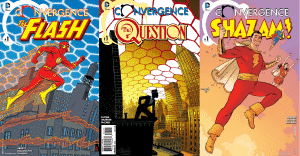
Best Story Worth Reading Regardless – Convergence Shazam (runners up – Convergence: Flash and Convergence: The Question)
Best Art – Evan "Doc" Shaner – Convergence: Shazam (runner up: Lee Weeks – Convergence:Superman #1 and Cully Hamner – Convergence: The Question)
Best Use of the Convergence Formula – Convergence: Flash (runner up – Convergence: Harley Quinn)
Most Sentimental – Convergence: World's Finest (runner up – Convergence Speed Force)
Best First Issue (with a second one that spoils it) – Convergence: New Teen Titans #1 (runner up – Convergence: Infinity Inc. and Convergence: Blue Beetle)
Best Second Issue (after a disappointing first) – Convergence: Speed Force #2
Best Character-based story: Convergence: The Question (runner-up: Convergence: Booster Gold)
Worst Story: Convergence #1-8
It's Graig Kent's birthday today. He's taking the day off work to maybe catch up on that pile of non-Convergence comics, or watch a Godzilla or Stanley Kubrick marathon, or read the entire Art of Masters of the Universe in one sitting. He's not even going to think about Secret Wars until it's out in trade.
Funerals for Friends, And Taking the Next Step: What Providence, Fight Club 2 and Captain Marvel Can Teach Us About Growing Up
By Adam X. Smith
As I write this, during the last days of May in my 28th year, I find myself at another crossroads in my life, and as much as I know our faithful readers love my little self-involved digressions into my personal life (note the sarcasm), this is going to be one of those weeks where you have to put up with a lot of this sort of thing, so strap in, bear down and deal with it.
First, a word for my friends, acquaintances and indeed any readers currently or imminently finishing school for the year.
As the junior partner of the Thor Comic Crew, I have a tendency to defer to my colleagues in matters of comic book history and so on, but as a university student I've been the oldest member of my immediate peer group for quite some time. Most of us have just finished our three-year degrees and will hopefully be graduating in September – some will even be pursuing Masters degrees, with any luck; thus I've had a deluge of excitable Facebook posts on this basis, but until now I've not really been able to articulate a cogent response to this pivotal time in our lives, apart making a glib remark about my lack of a response or just reposting Baz Luhrman's Sunscreen Song.
That said, and with the caveat that the Sunscreen Song still has some pretty good life advice in it, as someone who recently spent a considerable time learning about multimedia in a performance context and who reviews stuff as a hobby (this technically costs me money, so it qualifies as a hobby rather than a job), I've come to think that Peter Gabriel was right: just as we used to say that we are what we eat and wear, these days we are the media we consume. Thus, I'd like to take this opportunity to offer some potentially sage wisdom, based on deeper philosophical points gleaned from a couple of this week's new releases. Look grateful.
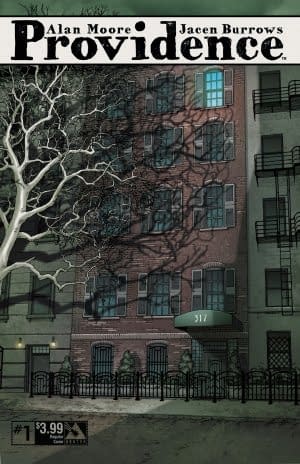
Nevertheless, the comic captures the tension and dread of Lovecraft's oeuvre, building slowly but surely from the opening pages, and with a twist that is typical of the genre completely recontextualises everything we have seen before it in the final panels and the text-based epilogue.
This is not accidental. More than simply retreading the work of Lovecraft or his own material, Moore's meticulous attention to detail can be seen in all aspects of the text, the art and the book's design itself, and beyond the metatextual references to Robert Chambers' "The King in Yellow" (itself experiencing a renaissance in popular culture thanks to HBO's True Detective), the book's central premise – a person being confronted with the consequences of not being true to themselves, and the hidden world beneath the surface of "civilised" society – transcends the historical and cultural context of its setting.
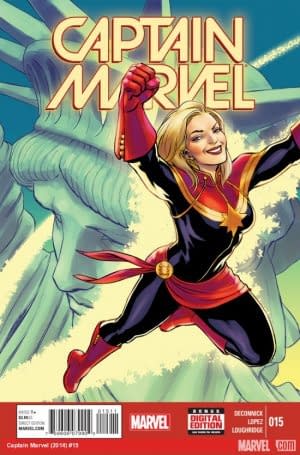
So after a jaunt as the Avengers' cosmic ambassador, most of which she spent getting roped into an intergalactic refugee crisis and fighting off space pirates with designs on her alien cat (don't ask), Carol Danvers' long-awaited return to Earth garners a pretty low-key reception. The reason? Tracy Burke, a friend from Carol's Ms. Marvel days, and one of only a few strong links to her old pre-amnesia life, has died after a long struggle with illness.
This doesn't come completely out of nowhere either – Tracy last appeared in the two-part Christmas story in issues #10-11, in a hospital bed, as the person Carol made the effort to check in on during her flying visit back to Earth. When Carol returns home to find she has come too late to say goodbye to her, she is devastated, and the rest of the book tells in flashback a touching story of how love and death can define our relationships, for better or worse.
When I last got genuinely misty-eyed over a comic's soap opera tendencies, it was because it keyed into my relationship with my parents and unresolved secrets and shames on both sides of that relationship; this time, it more closely reminded me of the loss of my grandparents, two of whom (not married/related biologically) died within a week of each other – one of them on the other side of the Atlantic from me and after a protracted battle with several debilitating strokes; DeConnick herself states in the afterword that the issue's plot was inspired by the loss of her own Aunt Polly last year. Indeed, one could look at this issue's denouement as not just a funeral for Tracy but for the character of Ms. Marvel and the current series as a whole, a quieter, more introspective capper to a run that has had more than its share of zany hijinks and sci-fi derring-do.
However, what prevents this story from being maudlin and depressing is that, through her last will and the bequeathing of her effects, Tracy tells Carol (and us) the story of how Carol helped her deal with the grief of losing her partner Teddy, and in turn, they help Carol deal with her loss too from beyond the grave, reminding her that life is for living and to not founder in melancholy, but to always move on to "the next right thing". And with one last joke at Carol's expense involving an urn and a day at the beach, the spirit of a woman who has been part of Carol's life since the days of Chris Claremont's first run with her, gives every single one of us some useful life advice:-
"Don't get stuck, Danvers. Next step, next page – – next adventure. I love you, kid. Have fun, be happy… and don't look back."
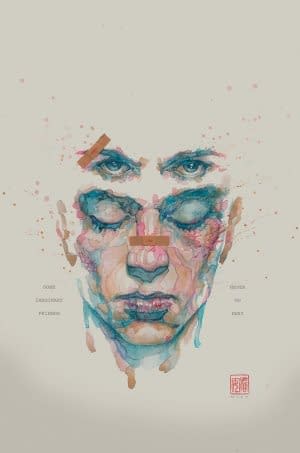
Nor is it a criticism, by the way – a central theme of the original novel and its film adaptation was how Western consumer-driven culture has a habit of turning people into miserable desk-bound misanthropes, ticking human time-bombs waiting to go off. Buying into a system that keeps you hungry for things you don't need and will never afford is an optimum breeding environment for the kind of people who Tyler Durden recruits into Project Mayhem, as well as the kind of people who romanticise the idea of an IRL fight club, completely missing the point that Tyler is not, never was, and never will be the good guy.
But under the swaggering peacock machismo and anarcho-fascism, Tyler did have some pretty valid things to say about how we live our lives and deal with loss: "Only after disaster can we be resurrected. It's only after we've lost everything that we're free to do anything."
So anyway…
Roughly ten years after the events of the novel and acting as a direct sequel to its epilogue, the now-middle-aged narrator – going by the name Sebastian these days – has spent a period in a mental institution scrubbing the remainder of Tyler from himself with therapy and medication and a dull office job, but can't seem to outrun the constant reminders of his past sins as founder of Fight Club and Project Mayhem. He is in an increasingly loveless marriage to Marla Singer with whom he has a son who goes mostly ignored by both of them, leaving him free to make potassium nitrate out of the neighbour's dog turds. "You know you can make nitroglycerin from fat?" he blithely tells his babysitter.
Meanwhile, Marla is up to her old tricks again, visiting a progeria syndrome support group to bitch about their ailing marriage and secretly swapping out Sebastian's many pills for aspirin and sugar. At night she whispers in his ear begging Tyler to return and deliver her from monotony. And boy does she get her wish, although probably not entirely the way she hoped for – as it turns out, Tyler never really left, and has been keeping busy, re-emerging at 50 minute intervals, three times a week for the last ten years to run his space monkey insurgency. Like I said earlier, Palahniuk doesn't pretend that Tyler is the good guy here, and his re-appearance as a controlling influence in Sebastian's life bodes ill for anyone he cares about.
Most authors who branch out into comics benefit from collaborating with artists that complement and build on their writing style, and in artist Cameron Stewart, colourist Dave Stewart (no relation… I think) and cover artist David Mack, Palahniuk has an exceptional team of comics veterans to make his work pop off the page. While never actively aping the appearance or design of the film adaptation – apart from in a well framed and obscured flashback image page and a sex scene complete with crashing trains and exploding zeppelins (again, don't ask) – the comic provides an interesting continuation of David Fincher's cold-blue desaturated look with explosive injections of the kind of cartoony vibrancy that made Stewart's art for Grant Morrison's Thunderworld the only part of Multiversity I can muster any genuine enthusiasm for.* There are even moments when Sebastian's pills and stray rose petals discreetly block out parts of the panels, lampshading the disconnect inherent in the main character's perception of reality in a way that the novel could only hint at and that the film could only represent cinematically.
So there we have it, ladies and gentlemen of the class of 2015: be true to yourselves, don't get stuck in the past, and remember that you can make napalm out of equal parts gasoline and cat litter. Nooj.
Adam X. Smith is married, has just finished three years of university and will very soon (probably) have legit acting and writing credits. Therefore he should probably start acting like a grown-up and leave these childish things behind. In the meantime, he writes for Bleeding Cool and @ElectrolyteMag and occasionally tweets stuff he likes under @RadicalAdZ.
*Upon hearing this, when I met him at a signing in Birmingham this Friday just gone (picture below if you don't believe me; you might need to follow me on Twitter to see it), Mr Stewart was quick to defend Frank Quitely's work on Pax American, as any good brother artist would; indeed, while I will allow that Quitely's draughtsmanship is never below par, it can't always elevate a story that simply leaves me cold – Jupiter's Legacy is another pertinent example.
(https://twitter.com/RadicalAdZ/status/604450162057052160/photo/1)
Secret Wars: Where Monsters Dwell #1
Secret Wars: Old Man Logan #1
Uncanny Avengers: Ultron Forever #1
By Jeb D.
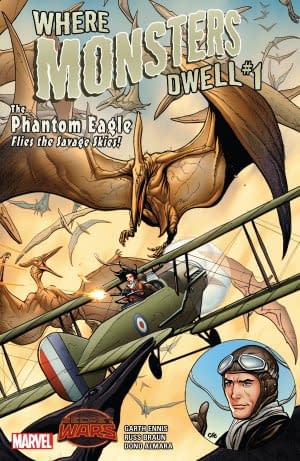
Ennis first introduced us to Karl Kauffman in his MAX series War Is Hell: First Flight of the Phantom Eagle, but in Where Monsters Dwell, he's tidied the character up a bit for more general consumption, and knowledge of the prior series is unnecessary. Ace pilot Kauffman is presented here as a typically roguish 1930's pulp-fiction hero in an exotic jungle setting, but he's also a classic Ennis pisstake on the imperialist impulses of the society that birthed those stories. Ennis and artist Russ Braun (with wonderful coloring from Dono Sanchez Almara) use our expected affection for such throwback adventurers to set us up for Kauffman's encounter with a "damsel in distress" that follows the pulp playbook for the first half of the issue, the reader just gliding along on the simple pleasures of sharp dialog, and beautifully rendered fight and flight sequences. Ennis gradually begins to turn all this on its head, subverting our expectations, so that by the time our characters encounter the pteranodons promised by Frank Cho's cover, it appears that this story is taking place in the Battleworld version of the Savage Land; and my fondest hope would be that the subsequent issues show us Ennis casting his cynical eye on the Ka-Zar/Tarzan white jungle hero archetype.
I also have to give this issue good marks in terms of value-for-money: though it ends on a great full-page joke that sets up what's to come, Ennis and Braun don't make the dinosaurs a "come-back-next-issue" tease: the sequence of Kauffman and the woman he has "rescued" desperately maneuvering their biplane through the flock of angry aerial monsters is both thrilling and hilarious. To the extent that it's a selling point, so far, this series gives every indication of being related only very tangentially to the whole Secret Wars meghilla, and it's one of the most satisfying first issues of any comic I've read in quite some time.

Old Man Logan is able to use its established future-world setting to effortlessly hit the necessary marks for a Secret Wars tie-in, its cast of characters familiar Marvel faces in unexpected places, its neither-616-nor-Ultimate universe the perfect backdrop for Logan's quest to solve the bloody, final (?) mystery of Ultron. Colorist Marcelo Mariolo borrows the burnt-desert palette from the classic Westerns of Leone and Peckinpah, with Sorrento's layouts blending those widescreen vistas with vicious, quick-cutting panels that are as effective at building tension as they are at letting loose with breakneck action. This issue's final pages leave no doubt that we're firmly in Doom's world, and it's thrilling to be reminded just what a compelling hero Logan can be when he decides to take on overwhelming odds. Secret Wars is a strong two-for-two so far this week.
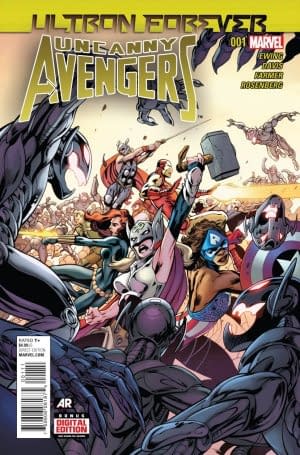
Jeb D. continues to write about comics when everyone else is blogging. And what is about these kids with their baggy jeans and hippity-hoppin' music, anyway?
Captain Canuck #1 (Chapter House Comics, $3.99)
By Graig Kent
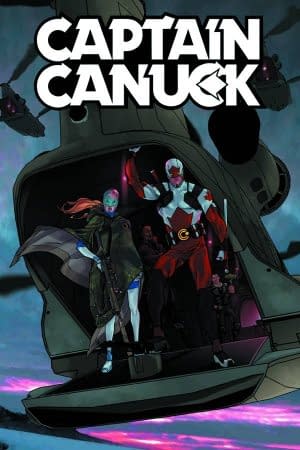
From the outside we're seen as a clean, polite, progressive and safe nation. Living within our borders I can't say that's entirely true but comparative to so many places internationally I can see how the reputation persists. We're not blindly patriotic (except maybe about hockey), we know we're not an infallible entity. We're self-aware and self-deprecating, we have a good sense of humour about ourselves (which explains why so many comedians and comedic actors come from here). So where a Captain America or a Captain Britain can stir a lot of patriotic feelings in the people of more prideful nations, Captain Canuck for so long couldn't hit the mark. Sure he made it onto our postage stamps for a time (in a series that also featured Superman far more prominently, since Joe Shuster was born Canadian we like to stake some small claim to him) but sheerly by using the moniker "Canuck" it made the character seemed unintentionally tongue-in-cheek. Plus, we're Canada…our cities are small, our land is vast, and nothing bad really happens here (besides 6 months of winter), so what would a superhero do here anyway? What exactly would they represent? Captain Canuck at first blush seemed more representative of our good humour, rather than any aspect of our national identity.
Times have changed since Captain Canuck's first publication run ended over 30 years ago. Our major cities have grown, the largest of which are now considered world-class, and while the national identity may still struggle to find itself, these cities now have identities all their own. Having a Toronto or Montreal-based superhero seems less like a joke and more of a necessity to give them the real status and cache they've earned (hell, the Joker and Batman were just seen fighting in Toronto last week). Plus, with the prevalence of superheroes and comic book characters in big budget film and television, superheroes are more than just characters in spandex tights fighting other guys in spandex tights. They are today's action heroes saving the day from whatever crisis may arise and there's no place on earth that can't use a hero.
With Captain Canuck #1, it seems like we're finally getting the Canadian comic book superhero icon we deserve… one that feels Canadian, but not exclusively so.
The comic opens with an homage (or perhaps it's just coincidental) to the opening of Captain America: Winter Soldier, as Captain Canuck leaps out of the back of a cargo plane with no parachute. He lands in the middle of an an inferno at an Alberta oil sands refinery. His high-tech suit protecting him from the heat and toxic fumes, but only for a limited time. His mission is not to squelch the blaze but to save the remaining people trapped in the facility. The mission is made more complicated when the only people he encounters are highly aggressive and zombie-like.
The good news is Captain Canuck is not alone in his mission. He has whole support team on that cargo plane and in a secret facility in Nunavut. They all are part of Equilibrium, an international task force funded by Captain Canuck's genius brother, Michael, who himself is on a self-appointed mission in Toronto to discover why his empire has fallen apart seemingly overnight.
What works best here is the book thrusts you right into the middle of the action, its characters and setting. It's not an origin story in the slightest, instead presenting a well-formed universe of established (and culturally diverse) characters with assured interpersonal dynamics. Captain Canuck and the Equilibrium agency feel lived in and experienced (no doubt in part due to the Captain Canuck animated web series having already given the creators time and experience with developing their world), which draws out the reader's desire to more. What are Captain Canuck's powers? How did he get them? Why did his brother establish Equilibrium? How did the Equilibruim team get formed? By avoiding the straight on origin, the strengths of the characters and its settings prove they can stand on their own.
Just as Captain Canuck and Equilibrium could easily be inserted into the Marvel Universe or DCU (especially given how criminally underused/underdeveloped Canada is in those universes), from a production standpoint, this is a book on-par with any mainstream book on the stand. Kalman Andrasofszky's fast-paced, action-fuelled script and his clean, richly detailed, expressive and energetic art are both already mainstream tested. As well, the redesign of Canuck — into something more battle gear than spandex — modernizes the character, attractively so. With superior color work from Jim Charalampidis and some impressive creative design, this is a fully formed package that defied my preconceptions/misconceptions of what a fully Canadian superhero comic could be (anyone raised with Canadian television or movies from the 80's or 90's or earlier is conditioned to being shocked when a Canadian product steps up to the same level of its American counterparts).
Beyond the main story, the book offers the first part of a back-up feature from Ed Brisson (Sheltered, Secret Avengers) and Marcus To (Red Robin, New Warriors) starring Captain Canuck circa 1982 (as he squares off against mermen attacking an oil rig off the coast of Newfoundland). It's only a slight taste of vintage Canuck, but setting it in 1982 makes the full spandex garb far easier to embrace (and the bushy lumberjack beard is so wonderfully Canadian).
It may not seem revolutionary– a straightforward, high quality, Canadian-produced, set-in-Canada superhero action comic — but outside of the original Captain Canuck, Alpha Flight and marginally last year's Justice League United, we haven't really had this (sorry, Wolverine is about as Canadian as William Shatner… we'll still claim him as ours, but he's really an ex pat). It is genuinely exciting, and, moreover, it's actually good.
Proud Canadian Graig Kent's first novel, Quarter City, is for some reason set in a fictional city Massachusetts. It can be read for free on the Wattpad app. Set in alternate universe, the story is framed around society's reactions to beings with super powers, focusing on the extreme actions of the city's most powerful Enhanced in particular. Also, he used "Enhanced" long before the Marvel Cinematic Universe ever did. Graig sometimes tweets stuff @thee_geekent and he does various other things in other places.










